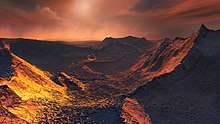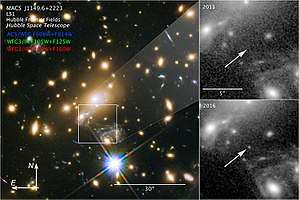Barnard's Star b
Barnard's Star b (also designated GJ 699 b) is a candidate super-Earth-like exoplanet and ice planet that orbits Barnard's Star in the constellation of Ophiuchus. The exoplanet's discovery by an international team of astronomers – including the European Southern Observatory and Carnegie Institution for Science – was officially announced on 14 November 2018.[2] It is the first confirmed planet orbiting Barnard's Star, which is six light-years away from Earth.[3]
 Artist's impression of the surface of a super-Earth orbiting Barnard's Star | |
| Orbital characteristics[1] | |
|---|---|
| 0.404±0.018 AU | |
| Eccentricity | 0.32+0.10 −0.15 |
| 232.80+0.38 −0.41 d | |
| Physical characteristics | |
| Mass | ≥3.23±0.44 M⊕ |
| Temperature | ≲105±3 K |
Characteristics
Barnard's Star b technically remains a planet candidate as it has been proposed with a confidence figure of 99%. The research team that made the announcement will continue observations to ensure that no improbable variations in brightness and motion in the star might account for the discovery. Direct imaging opportunities of the planet from large ground-based telescopes, or potentially the WFIRST telescope, are expected within ten years of 2018. There is an outside chance that a transit of the star might also allow for imaging.[4]
The planet was proposed through the radial velocity method, the most common planet-hunting technique. A "wobble" observed in Barnard's Star's motion was confirmed to have a period of about 233 days, corresponding to a semi-major axis of 0.4 AU for a proposed companion. The mass of the likely planetary body was then deduced to be about 3.2 Earth mass. Analysis was careful and extensive. Lead astronomer Ignasi Ribas notes: "We used observations from seven different instruments, spanning 20 years of measurements, making this one of the largest and most extensive datasets ever used for precise radial-velocity studies."[5]
Barnard's Star b is expected to be frigid, with an equilibrium temperature of around −170 °C (−274 °F; 103 K). Its orbital distance, though close to the star by solar system standards, is around the snow line for a dim red dwarf like Barnard's Star. This is the point where volatile compounds such as water condense to form ice and thus outside the assumed habitable zone where temperatures are right for surficial liquid water. However, new research suggests that heat generated by geothermal processes could warm pockets of water beneath the surface of the planet, potentially providing havens for life to evolve.[6]
Astronomers expect to find more such "snow line" planets as proto-planetary accretion is favorable in this temperature range. A second planetary companion for Barnard's Star has been suggested based on unconfirmed "wobbles" in the current system.[4]
References
- Ribas, I.; Tuomi, M.; Reiners, A.; Butler, R. P.; et al. (2018-11-14). "A candidate super-Earth planet orbiting near the snow line of Barnard's star" (PDF). Nature. Holtzbrinck Publishing Group. 563 (7731): 365–368. arXiv:1811.05955. Bibcode:2018Natur.563..365R. doi:10.1038/s41586-018-0677-y. ISSN 0028-0836. OCLC 716177853. PMID 30429552. Archived (PDF) from the original on 2019-03-26.
- Rincon, Paul (2018-11-14). "Planet found circling neighbouring star". BBC News. Archived from the original on 2019-04-21. Retrieved 2018-11-15.
- Anderson, Paul Scott (2018-11-14). "At last, a planet for Barnard's Star". EarthSky. Archived from the original on 2019-04-24. Retrieved 2018-11-15.
- Billings, Lee (November 14, 2018). "A Frozen Super-Earth May Orbit Barnard's Star". Scientific American. Archived from the original on April 12, 2019. Retrieved November 19, 2018.
- Wall, Mike (November 14, 2018). "Icy 'Super-Earth' Exoplanet Spotted Around Nearby Barnard's Star". Space.com. Archived from the original on 2019-03-26. Retrieved November 16, 2018.
- Redd, Nola Taylor (2019-01-10). "Barnard's Star Planet May Not Be Too Cold for Life After All". Space.com. Archived from the original on 2019-05-15. Retrieved 2019-01-17.

